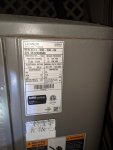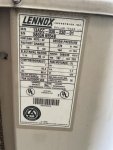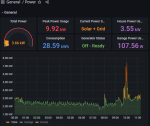EmbarkChief
Member
- 86
- 2
- 8
- Location
- Houston, Texas
I'm happy I came across this thread! I'm in Houston as well and have the same questions and concerns as Ham & Eggs. I keep going back and forth between a Honda EU7000 and either a MEP-802 or 803. I have home electrical monitoring as well, not as extensive as Ham & Eggs LOL but it keeps me informed of my draw at any given time.
I have a 3k+ sqft house with a 3 ton and 2 ton AC units. Running watts with both units and normal household draw is about 6,500 watts this load occurs around every 15 min with a load time of 10 minutes during a typical 100 deg day (like today!). The 3 ton downstairs unit has a starting load of anywhere between 4200 and 3400 watts with a running load of 2600. The 2 ton upstairs unit has a starting load between 3500 and 2800 wats with a run load of 2000 watts. If I only run the downstairs AC along with a typical household load my usage is about 3,700-4000watts. The largest load I have hit so far was around 8000 watts and that came from turning on my electric oven with both AC's going. Everything else (water heaters, dryer, stove) is gas.
With all that in mind I'm not sure if I'd load an 803A enough with my typical load requirements too keep wet stacking at bay. Although I could always turn on the oven every now and then to load it up. I feel like the lazy option is just to get a EU7000, but the more heavy duty option would be a MEP. So many advantages and disadvantages to either one.... Makes for a hard decision. When hurricane IKE came through back in 2008 I was without power for 3 weeks. I don't ever want to to that again, especially now that I have kids. During the freeze I was out for 3 days. My neighbor had a hard time keeping his 20K Generac going under heavy loads due to low gas pressure. I'm not as worried about fuel price as I am about fuel availability. In my experience during hurricanes unleaded runs out fast but you can typically still find diesel. I have 7 Jerry cans (5 gal) for this purpose.
I have a 3k+ sqft house with a 3 ton and 2 ton AC units. Running watts with both units and normal household draw is about 6,500 watts this load occurs around every 15 min with a load time of 10 minutes during a typical 100 deg day (like today!). The 3 ton downstairs unit has a starting load of anywhere between 4200 and 3400 watts with a running load of 2600. The 2 ton upstairs unit has a starting load between 3500 and 2800 wats with a run load of 2000 watts. If I only run the downstairs AC along with a typical household load my usage is about 3,700-4000watts. The largest load I have hit so far was around 8000 watts and that came from turning on my electric oven with both AC's going. Everything else (water heaters, dryer, stove) is gas.
With all that in mind I'm not sure if I'd load an 803A enough with my typical load requirements too keep wet stacking at bay. Although I could always turn on the oven every now and then to load it up. I feel like the lazy option is just to get a EU7000, but the more heavy duty option would be a MEP. So many advantages and disadvantages to either one.... Makes for a hard decision. When hurricane IKE came through back in 2008 I was without power for 3 weeks. I don't ever want to to that again, especially now that I have kids. During the freeze I was out for 3 days. My neighbor had a hard time keeping his 20K Generac going under heavy loads due to low gas pressure. I'm not as worried about fuel price as I am about fuel availability. In my experience during hurricanes unleaded runs out fast but you can typically still find diesel. I have 7 Jerry cans (5 gal) for this purpose.
Last edited:









